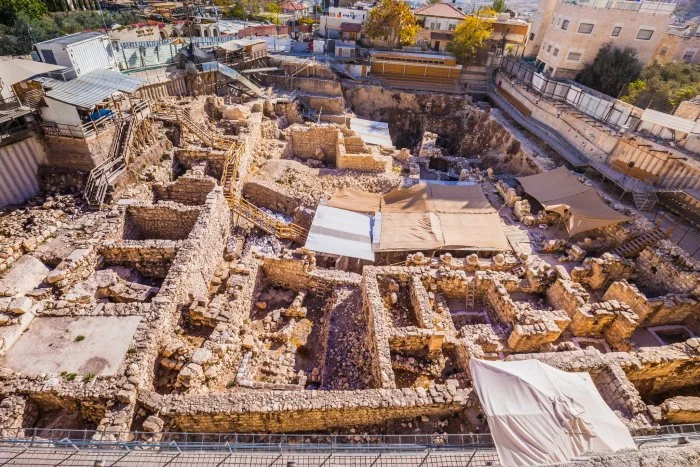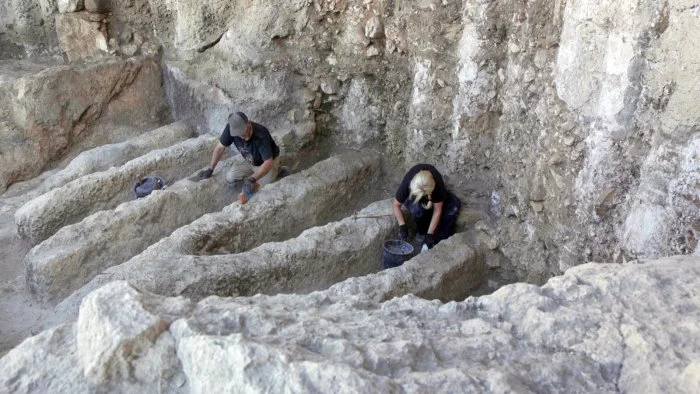Archaeologists Find Mysterious 2,800-year-old Channels Near Temple Mount in Jerusalem
Deep grooves cut into the bedrock date to the biblical Kingdom of Judah, and bolster the theory of Jerusalem’s early expansion. But what purpose they served remains a riddle
Scientists are trying to solve an ancient Jerusalem mystery. What was the function of the Channel Installation discovered in the City of David National Park, dating to the days of Kings Joash and Amaziah?

An ancient channel installation, the first of its kind ever discovered in Israel, was in use around 2,800 years ago – during the First Temple period. Investigators from the police forensic unit joined to solve the mystery, but so far – to no avail.
According to researchers from the Israel Antiquities Authority and Tel Aviv University, “The channels were likely used to soak some type of product. Their central location indicates that the product was connected to the Palace or Temple economy”.
The excavation findings will be open for public viewing during the 24th City of David Studies of Ancient Jerusalem conference to be held next week.
What was this obscure product that was important to the economy of the city, Temple or Palace during the times of the ancient Judean Kings? Unique and large-scale production installations carved out of the rock and dating to the 9th Century BCE were unearthed in excavations conducted by the Israel Antiquities Authority and Tel Aviv University in the City of David National Park, funded by the Elad Foundation.


The purpose of the installation is still unclear, but their uniqueness and location near the Temple and the Palace suggest that their products were integrated into the economy of these prominent institutions.
The excavation thus far has uncovered two installations about 10 meters apart, which may have composed one large installation. Such structures have not been found anywhere else in Israel, hence their uniqueness.
The excavators found the first installation at the northeastern end of the Givati Parking Lot excavation, which includes a series of at least nine channels that were smoothed. On top of the rock cliff that encloses the installation to the south can be found seven drain pipes, which carried liquid from the top of the cliff, which served as an activity area, to the channel installation.
Dr. Yiftah Shalev, a senior researcher at the Israel Antiquities Authority, said: “We looked at the installation and realized that we had stumbled on something unique, but since we had never seen a structure like this in Israel, we didn’t know how to interpret it. Even its date was unclear.
We brought a number of experts to the site to see if there were any residues in the soil or rock that are not visible to the naked eye, and to help us understand what flowed or stood in the channels. We wanted to check whether there were any organic remains or traces of blood, so we even recruited the help of the police forensic unit and its research colleagues around the world, but so far – to no avail.”
“The mystery only grew deeper when we found the second installation to the south,” says Prof. Yuval Gadot of Tel Aviv University’s Archeology and Ancient Near Eastern Civilizations Department.
“This installation consists of at least five channels that transport liquids.
“Despite some differences in the way the channels were hewn and designed, it is evident that the second installation is very similar to the first, “Gadot adds.
“This time, we also managed to date when the facility fell out of use – at the end of the 9th Century BCE, during the days of the biblical kings of Judah – Joash and Amaziah. We assume that the two installations, which, as mentioned, may have been used in unison, were constructed several decades earlier.”
According to Prof. Gadot, “This is an era when we know that Jerusalem covered an area that included the City of David and the Temple Mount, which served as the heart of Jerusalem. The central location of the channels near the city’s most prominent areas indicates that the product made using them was connected to the economy of the Temple or Palace. One should note that ritual activity includes bringing agricultural animal and plant produce to the Temple; Many times, Temple visitors would bring back products that carried the sanctity of the place.”


“Since the channels don’t lead to a large drainage basin and the direction of their flow varies, it is possible that the channels, at least in the northern installation, were used to soak products – and not to drain liquids,” adds Dr. Shalev.
“The production of linen, for example, requires soaking the flax for a long time to soften it. Another possibility is that the channels held dates that were left out to be heated by the sun to produce silan (date honey), like similarly shaped installations discovered in distant places such as Oman, Bahrain and Iran.
” Dr. Shalev notes that “in the near future, we will take additional soil samples from the installations, and try – once again – to identify components that can help us solve the mystery: what was the product that was important for the economy of the city, Temple or Palace?”.
According to Eli Escusido, director of the Antiquities Authority, “the ancient channel installations we have before us are fascinating and stimulate the imagination. The excavations in the City of David, which cover vast areas compared to densely populated Jerusalem, are revealing to us more and more fascinating details from the time of the Judahite kings, of which there are relatively few finds in the Old City due to modern disturbances.
From time to time, we come across surprising, enigmatic finds that challenge us and spark research interest. With the help of collaboration with other institutions, we crack these mysteries and advance our knowledge of past societies; I congratulate all institutions for this successful collaboration”.



